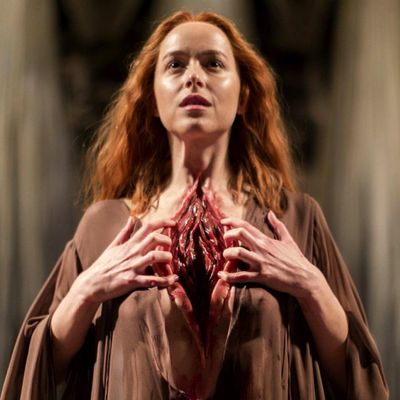
Luca Guadagnino’s remake of Suspiria is opening in limited theaters this weekend, and fans of the 1977 original film’s stylish violence will have a lot to process when they emerge. At two-and-a-half hours long, the amount of gore in Guadagnino’s Suspiria is actually quite small, but when the brutality is presented it comes in marathon stretches — one of which is teased in the trailer, and features a woman’s jaw being popped out of place by an unseen aggressor. But that sequence feels restrained compared to Suspiria’s grand finale, a Black Sabbath ritual that brings Susie Bannion (Dakota Johnson) eye-to-eye with the invisible force that has been silently pulling her towards the Helena Markos Dance Company in Berlin for her entire life. At the Sabbath, Susie must decide whether or not she will take her place among a coven that seeks to raise one of the most powerful witches in history — Mater Suspiriorum.
What begins as a quiet interface between Susie and the hideous, rotting crone that is the coven’s leader, Helena Markos, turns into a nightmare that collapses in on itself. Before long, there are possessed dancers, disemboweled naked women, exploding heads, and the walking incarnation of death itself — all set to a score by Thom Yorke. To figure out how it came together, Vulture spoke with Guadagnino, Mia Goth (who plays one of the academy’s star dancers), and choreographer Damien Jalet about how you control chaos and turn an orgy of blood into a meditation on melancholy.
Establish a History
One of the biggest deviations between old Suspiria and new (which was written by David Kajganich) is Guadagnino’s emphasis on the historical context of post–World War II Germany, a nation coping with the tensions of a Cold War that has left Berlin split in two. What happens inside the dance company unfolds alongside the hijacking of Lufthansa Flight 181 by the Popular Front for the Liberation of Palestine during the German autumn of 1977. All of this is to say, it was crucial to Guadagnino that his fantastical witch tale be grounded in the cruel realities of the time, and the same is true for how he approached the brutal bacchanalia at the film’s climax.
“It was all about the knowledge of how, say, the inquisition trials had created a narrative for Black Sabbath,” says Guadagnino, who researched Renaissance-era witch hunts that killed thousands across Europe. “What was the dynamic vis-à-vis what was the experience that you could draw from the trials of the witches in let’s say mid-16th century Europe? If you study accounts of the outcome of those trials, where women were indicted and forced to admit they had traded with the devil through these Black Sabbath rituals, they were brought to delirium to agree on the version of the judge — who was usually representative of the patriarchal and church powers.” Through research, the director picked out some patterns in the structure of the rituals, and knew that he wanted to incorporate a few recurring elements: A witness, played in this case by Dr. Klemperer (Swinton as Lutz Ebersdorf), the arrival of a Satanic presence, and the phenomenon of “coming out of yourself in ecstasy through dance.”
Location, Location, Location
Central to the lore of Suspiria is location. The Three Mothers — Tenebrarum, Lachrymarum, and Suspiriorum — are anchored to very specific residences in very specific cities in Dario Argento’s original trilogy (comprising Suspiria, Inferno, Mother of Tears). The buildings these movies take place in are intricately linked to the Mother witches, and become characters in and of themselves. While those hoping to see a faithful re-creation of the 1977 film might be disappointed by the new one, the setting for 2018 Suspiria is no less meticulously assembled than its forbearer.
The majority of Suspiria’s interiors come courtesy of a hotel that hasn’t been open to guests since 1968: the Grand Hotel Campo dei Fiori in Varese, Italy, at the foot of a mountain range near the Swiss border. Rooms in the Art Deco hellmouth, which sits atop a foothill and is slightly difficult to access, were outfitted as dorms for the dancers, a kitchen for the coven, fabulous living quarters for Madame Blanc (Tilda Swinton), and more — including a loggia that was transformed into The Room of the Feasts, where the Black Sabbath would take place.
“It was Luca’s idea to use hair,” the film’s production designer, Inbal Weinberg told the New York Times, which led to a weeks-long project for the design team, weaving hemp-fiber braids for “sculptural hairlike masses” meant to adorn the ritual chamber of the Mutterhaus below the Academy. “We conceptually decided that the texture of the wall is the hair of victims.” Once the Sabbath is fully under way and the whole spectacle feels like it’s exploded out of control, the array of dancers thrash around as the whole room turns deep red. If you can take your eyes off the participants long enough to notice the walls, you’ll see the hair of the victims lining it, and in the background, three grand gowns that each exceed ten feet in length hanging along the back wall. The mostly naked cast members gathered every day for a week in December to shoot this one scene, which came near the end of filming and unfolded over freezing cold-days.
Give in to the Dance
The Sabbath couldn’t just be pandemonium. It was a precise ritual, and while choreographer Damien Jalet wanted to craft something more visceral and animalistic than what viewers had seen in Suspiria’s previous dance sequences, he needed to keep the performers connected to the purpose of the Sabbath. “We wanted to go from something pretty technical, mathematical, with a certain sense of elegance to something where the body becomes wilder and more and more distorted,” said Jalet, who drew inspiration from past shows he has choreographed, but didn’t want the performers movements to rigidly adhere to one specific discipline of dance. “The scene described something very chaotic, but I felt we needed to create something still very ritualized. I got inspired by an Indonesian dance at one point – it’s something that only women do on their knees and they just create these patterns and it goes very quick. I think one of the dancers nearly fainted when we shot that scene because it was so intense.”
As for what it was like inside the ritual, actress Mia Goth — who has never shied away from naked intensity in her burgeoning film career — had no idea what it would look like on-screen. “I’ve never filmed anything like that, and I doubt I’ll ever film anything like it ever again,” says Goth, who spends the whole Sabbath in a trance with her entrails on the floor in front of her. “When I saw it, I didn’t know what to expect. We really didn’t know what we had at all.”
The Heartache in the Horror
While Suspiria is Guadagnino’s first horror film, there’s a throughline of longing that connects much of his work and will feel familiar to fans of his less gory films, such as Call Me By Your Name and I Am Love. After Susie declares herself the risen Mother Suspiriorum, she literally pulls open her chest to expose her beating heart, letting in a torrent of lamentations. In the middle of the Sabbath, Susie from Ohio renounces the woman who birthed her, condemning her to death, and realizes every step she has taken in life has lead her to this Room of the Feasts. Amidst all the horror, Susie is killing an entire version of herself, and so Guadagnino wanted the feeling of loss to be palpable.
“Halfway through editing the sequence I said to Thom Yorke and Walter Fasano, my editor, that we had to instill a moment of deep melancholy, because when you become, you are evolving into a new person, and you’re mourning the end,” Guadagnino explains. “It’s the death of the previous version of yourself, which is what happens in the movie. We wanted to create a bridge between this fierce horror and this very melancholic sadness.”
As for what the heroine becomes at the end of Suspiria, the director did not construct the Sabbath as a final battle between good and evil, because this is not a movie about binary confrontations. The greater tension in the Sabbath scene, beyond Markos vs. Blanc, is which future Susie will choose for herself. “She is choosing to be who she is meant to be, which is what we should do in our lives all the time,” says Guadagnino. “Which doesn’t mean that she is choosing to side on one side. She transcends sides. She definitely is going towards the direction of what the title suggests, the direction of sighs and suffering.”


